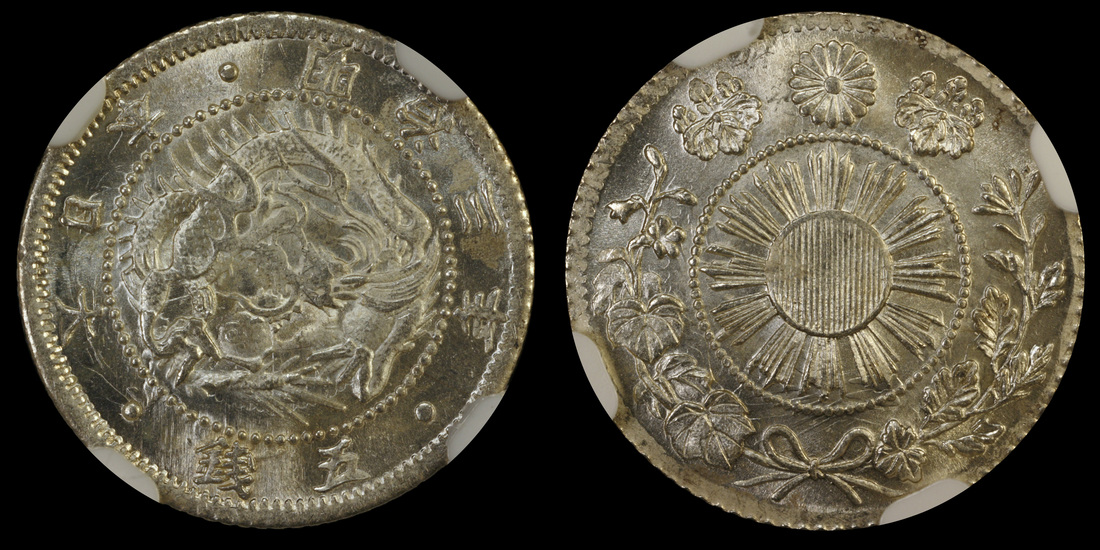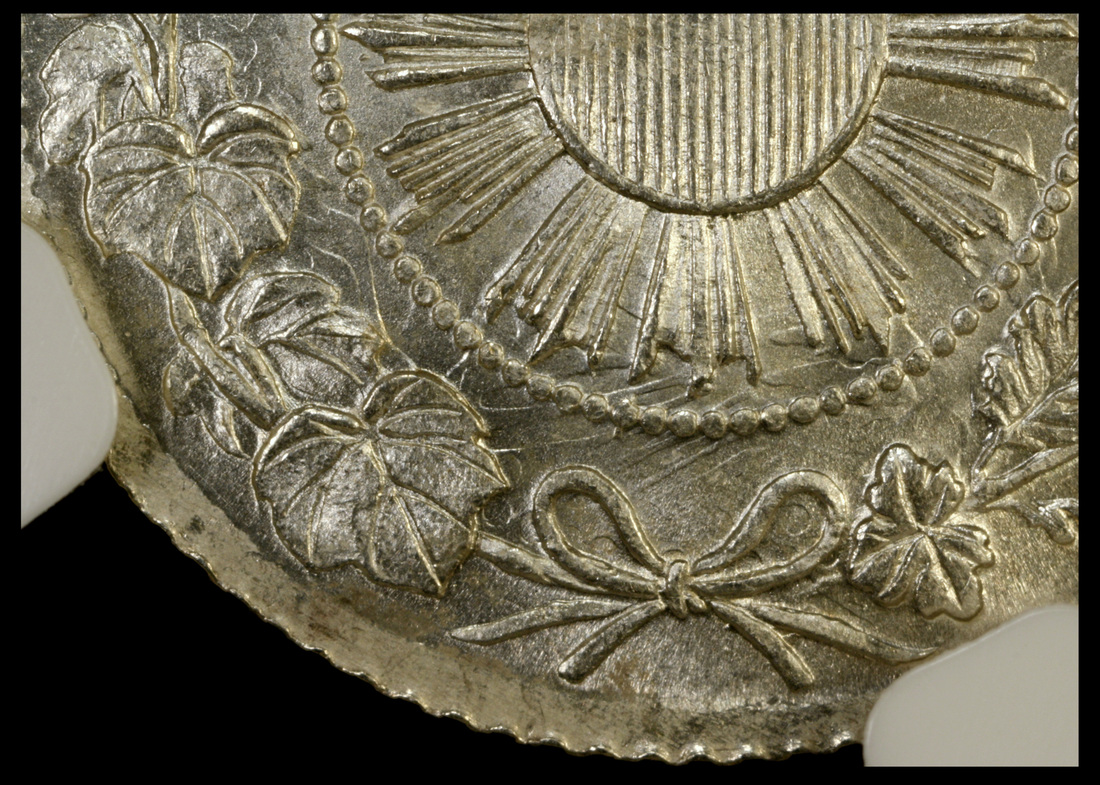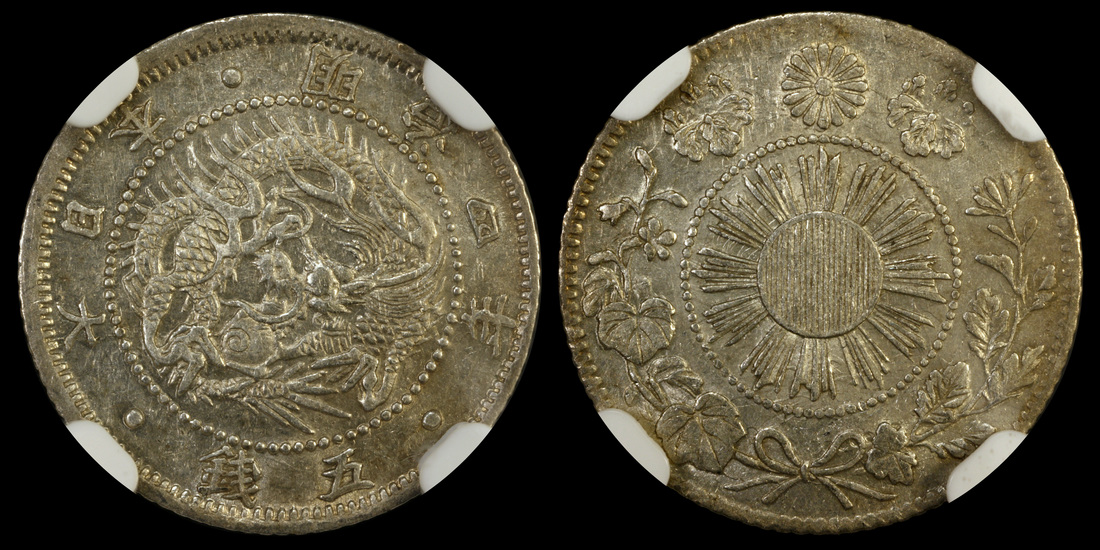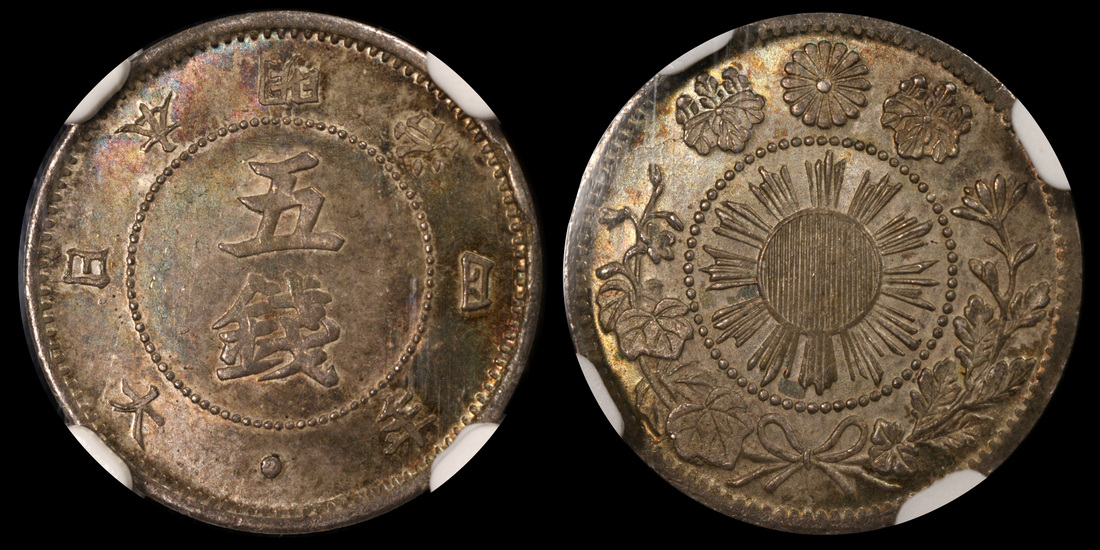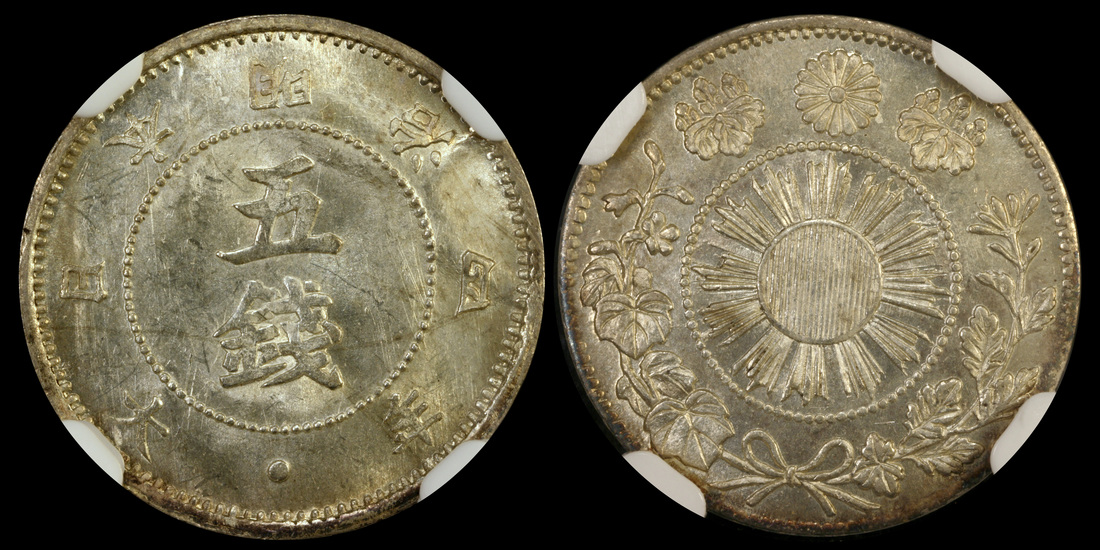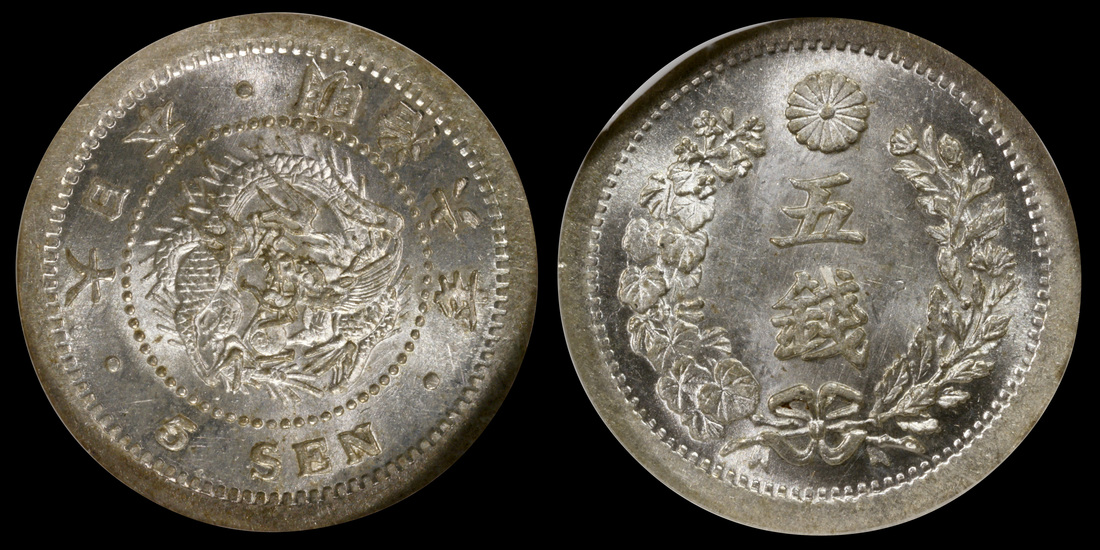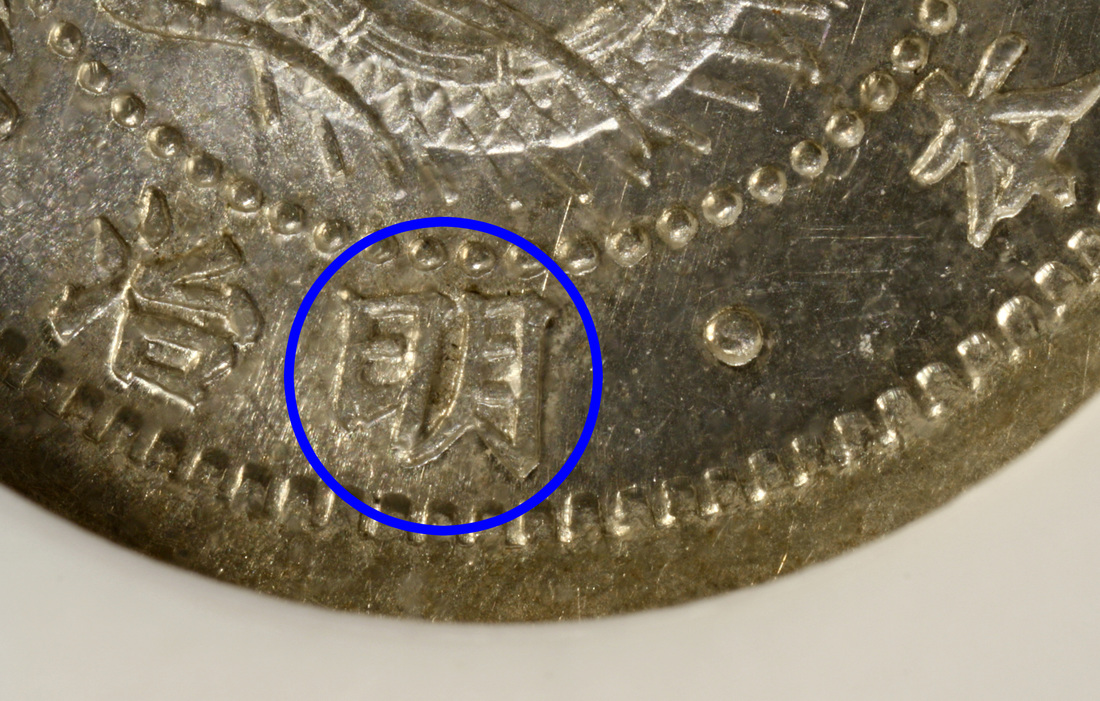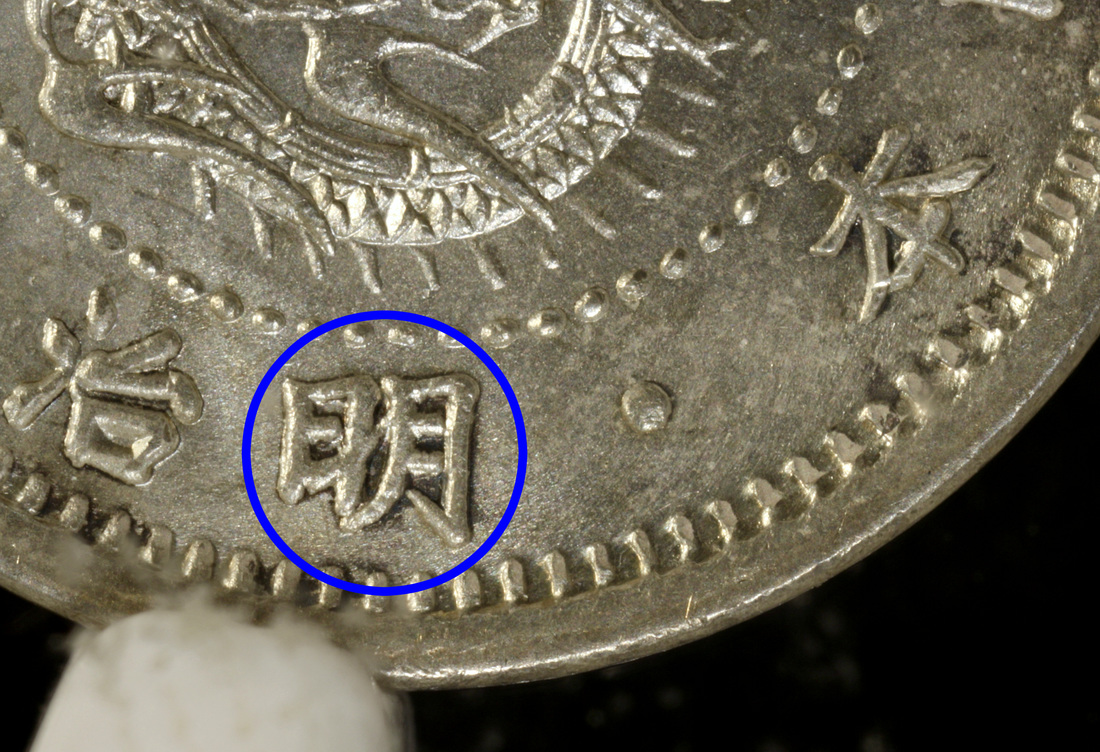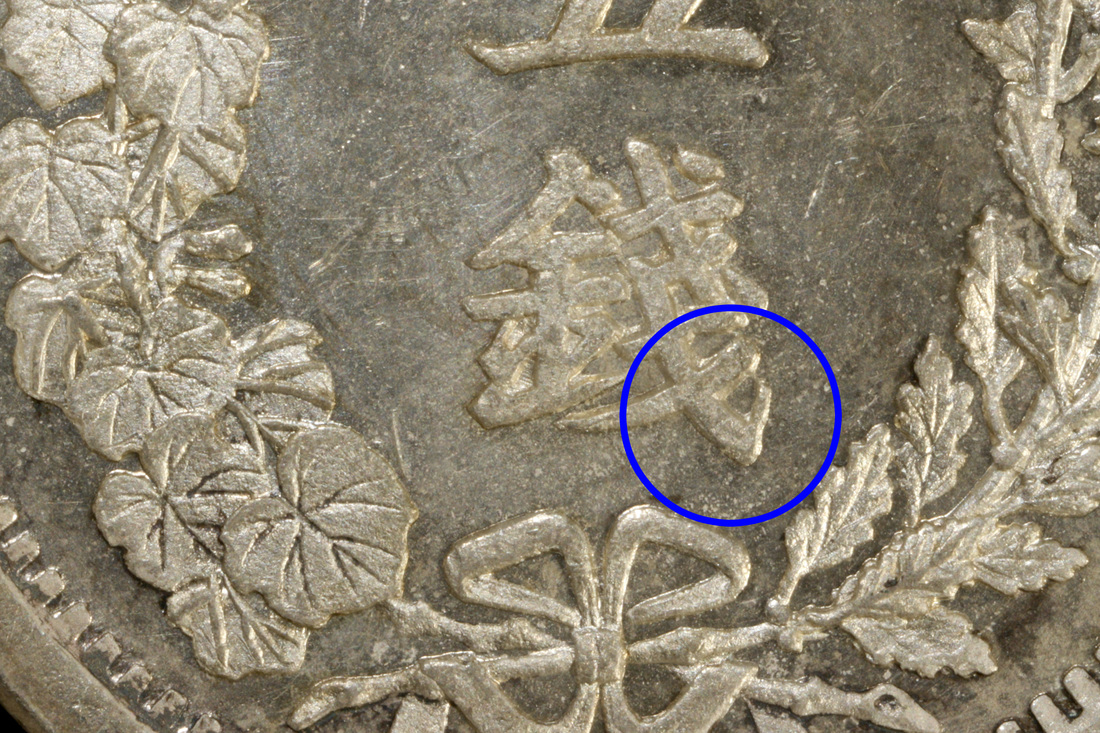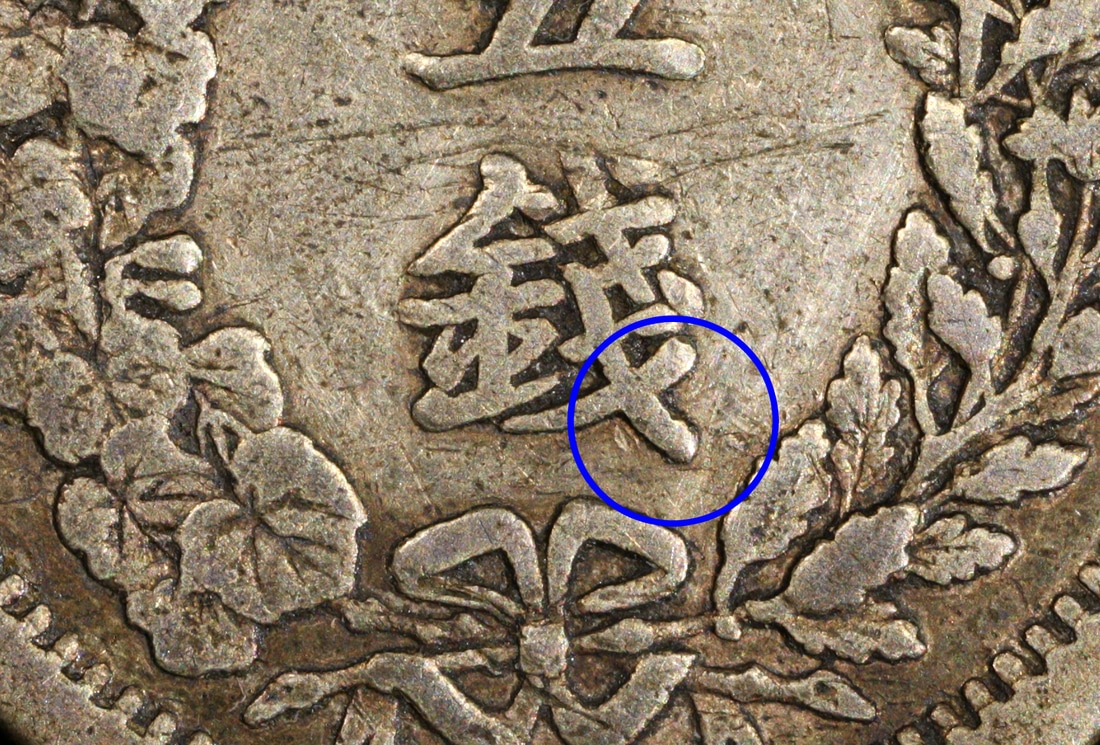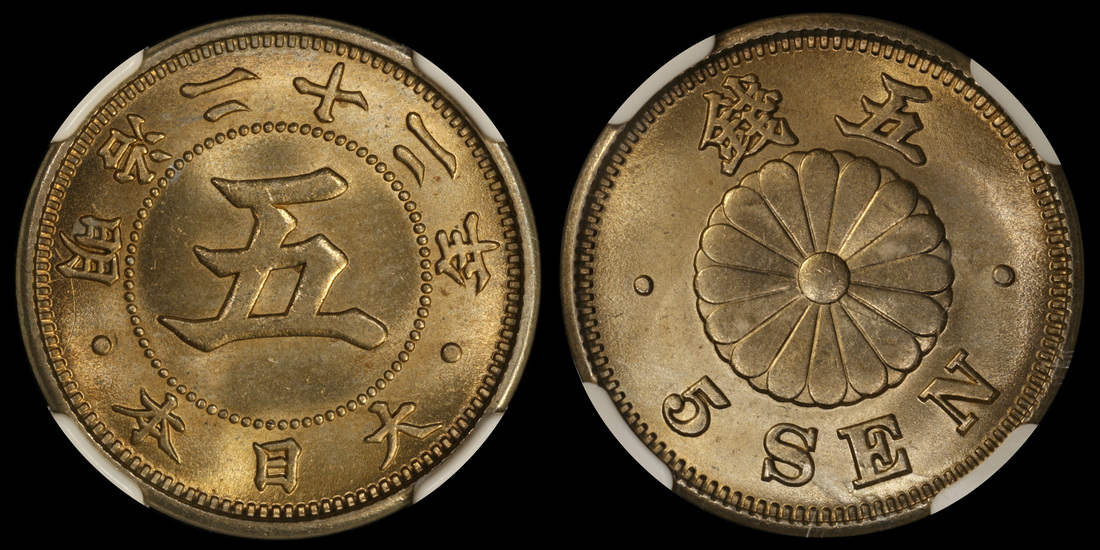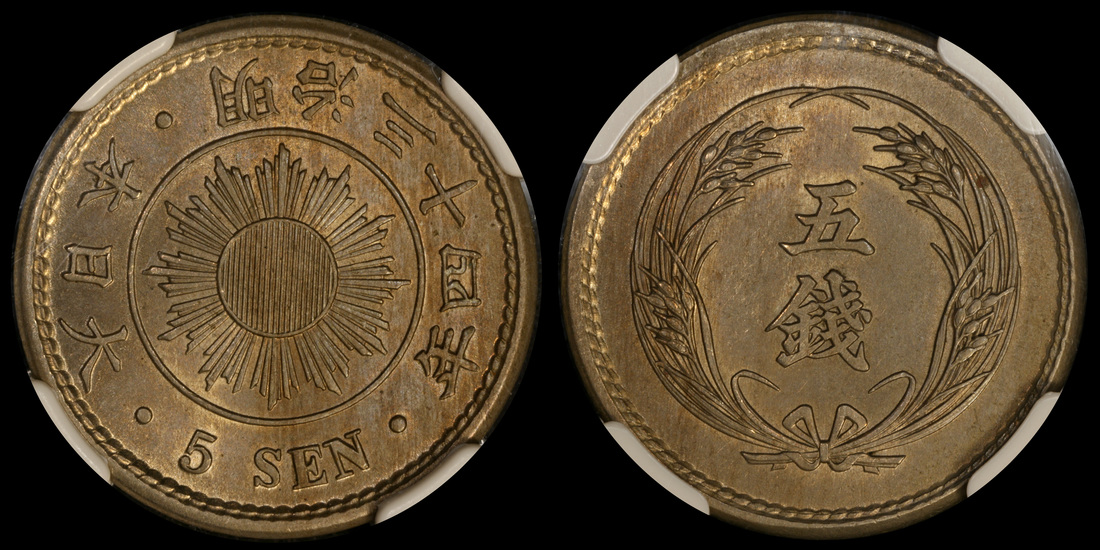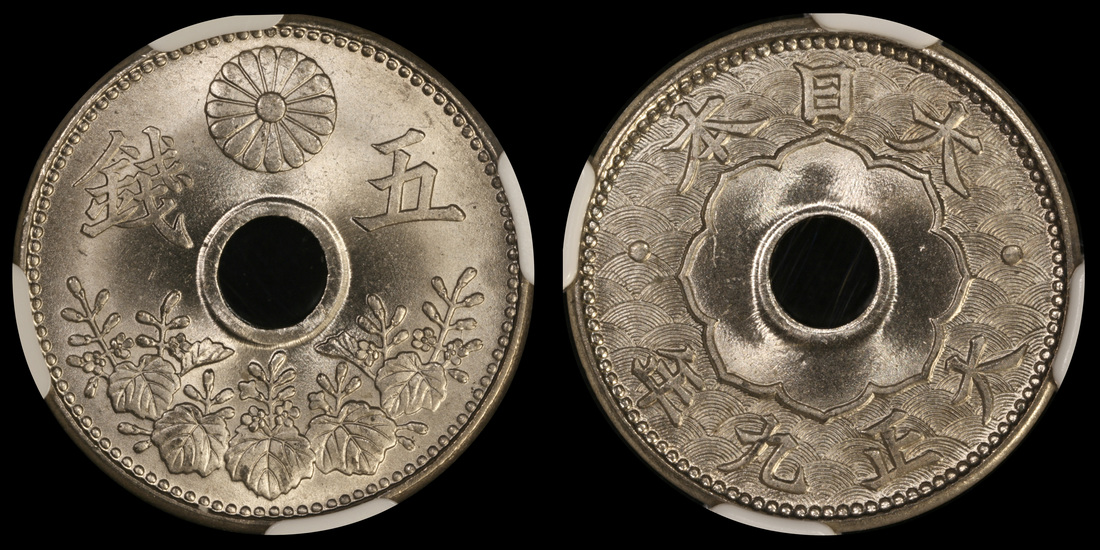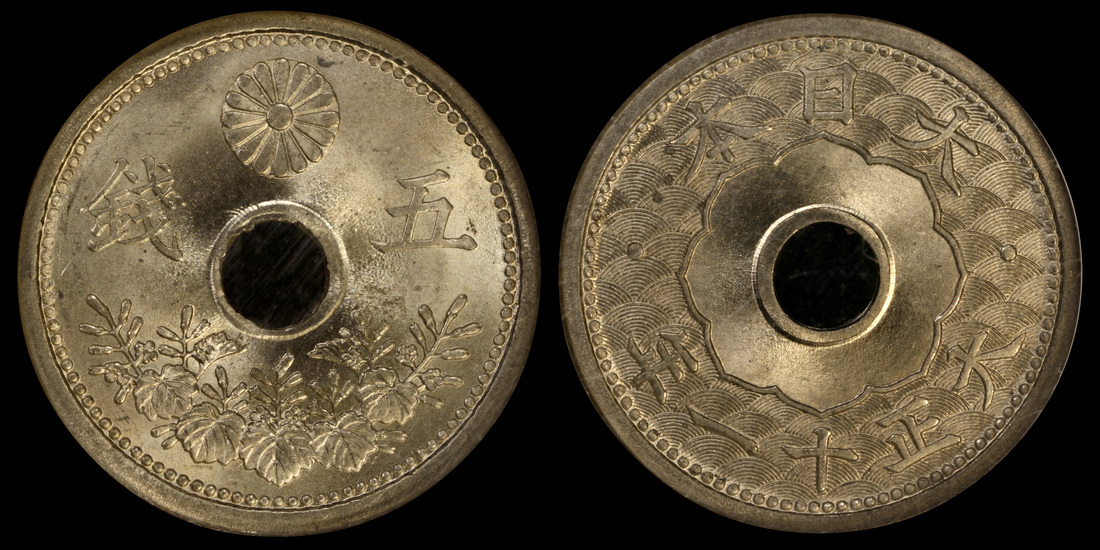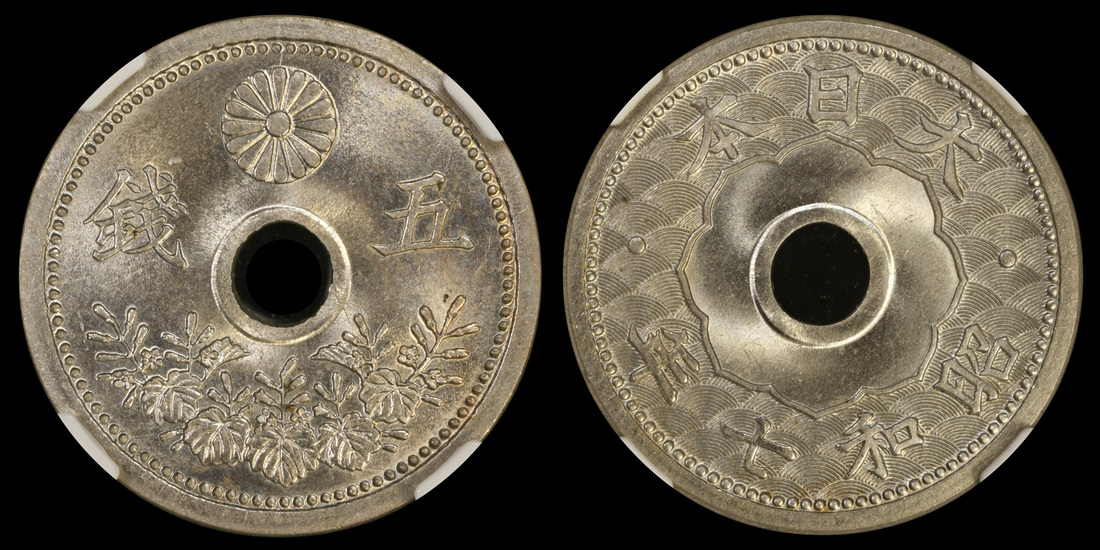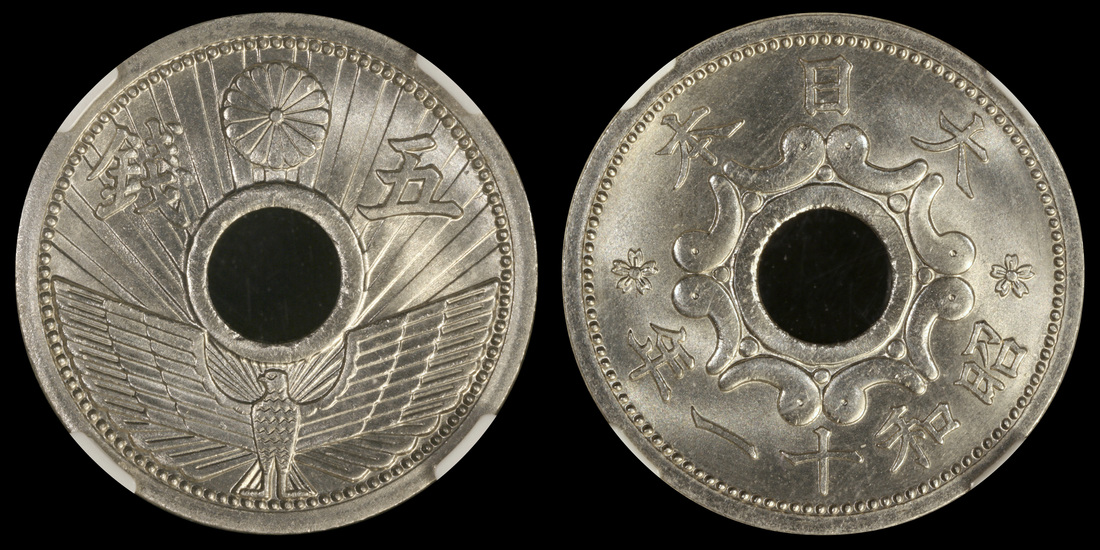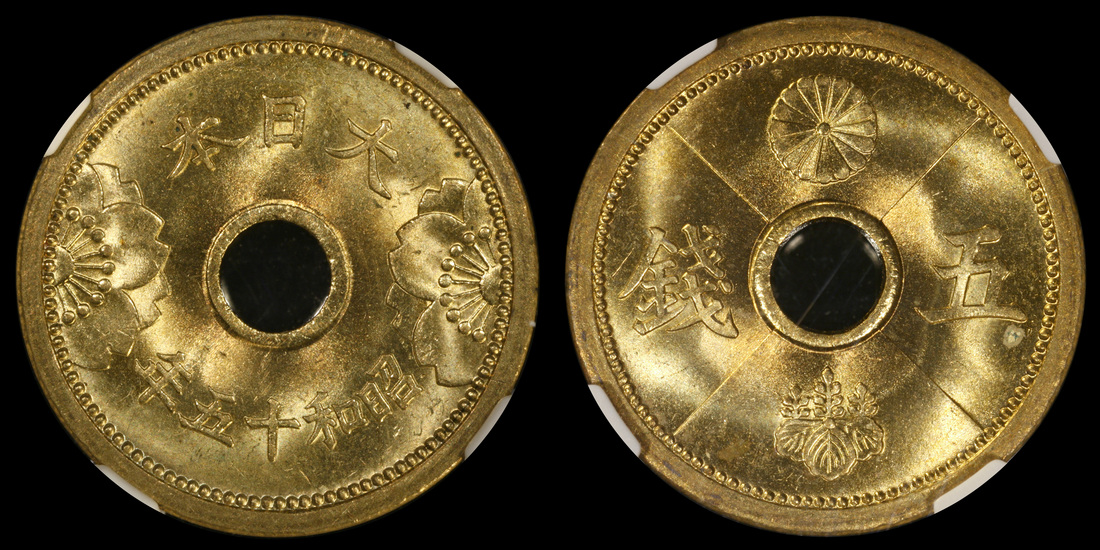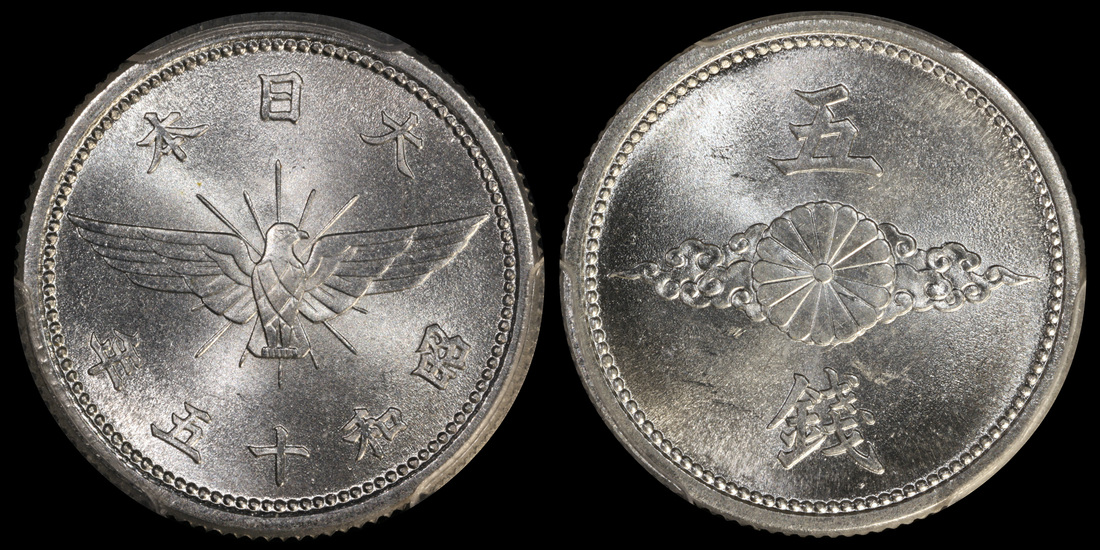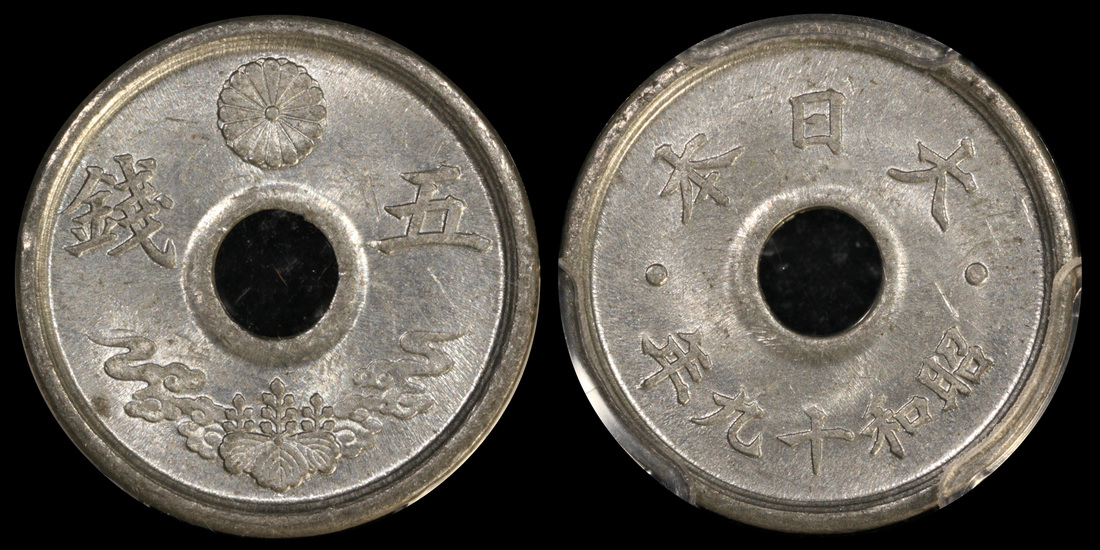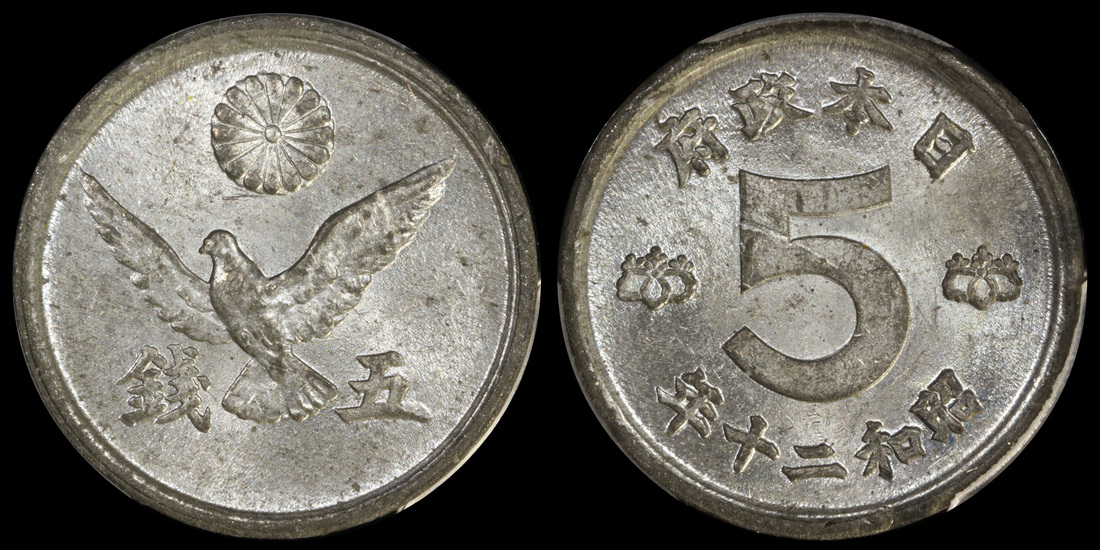Japan, 1870-19505 SEN
|
The first 5 sen coin was minted in 1870 and continued over several modifications, redesigns, and reductions until the final one was minted in 1945 when all denominations under 1 yen were made obsolete.
The following shows the progression of the 5 sen from the first through the last types produced, missing only a few examples (as noted). Also shown are the JNDA catalog numbers and associated commentary.
The following shows the progression of the 5 sen from the first through the last types produced, missing only a few examples (as noted). Also shown are the JNDA catalog numbers and associated commentary.
JNDA 01-33. The obverse dragon and reverse rising sun. This dual motif was represented by all the silver denominations produced in the years 1870-1871.
The first year shows two distinct varieties known as 'shallow' and 'deep' scales. The shallow version is the earlier type, and the design features are 'mushy' and did not strike up well. New dies were made with the much more distinct 'deep' scales.
Silver .800 fine. Diameter 16.15 mm. Weight 1.25 grams.
The first year shows two distinct varieties known as 'shallow' and 'deep' scales. The shallow version is the earlier type, and the design features are 'mushy' and did not strike up well. New dies were made with the much more distinct 'deep' scales.
Silver .800 fine. Diameter 16.15 mm. Weight 1.25 grams.
|
This coin is the shallow scales variety. I do not yet have a deep scale version for M.3/1870 to show in the 5 sen denomination, but the 10 and 20 sen coin sections do have example photos.
The combined mintage for both varieties in 1870 plus the 1871 issues is a total 1,501,473. |
This particular coin has some pronounced clashing as seen below.
This particular coin has some pronounced clashing as seen below.
JNDA 01-34. 1871 saw a second design --the 'large character' obverse replacing the dragon motif, while retaining the 'rising sun' reverse.
The coin has two varieties with relation to how many rays are around the sun, how many beads encircle the sun, and with difference in some of the foliage appearance.
The bead circle surrounding the sun is a little easier to identify via the spacing difference rather than tediously counting each ray and/or bead. Though the US third party graders specify the ray count, the JNDA indicates the ray count, the bead count and the design as distinguishing features. For those with more concerns about the details, the 53 rays has 65 beads, and the 66 rays has 79 beads.
Silver .800 fine. Diameter 16.15 mm diameter. Weight 1.25 grams (unchanged vs. the prior design).
The coin has two varieties with relation to how many rays are around the sun, how many beads encircle the sun, and with difference in some of the foliage appearance.
The bead circle surrounding the sun is a little easier to identify via the spacing difference rather than tediously counting each ray and/or bead. Though the US third party graders specify the ray count, the JNDA indicates the ray count, the bead count and the design as distinguishing features. For those with more concerns about the details, the 53 rays has 65 beads, and the 66 rays has 79 beads.
Silver .800 fine. Diameter 16.15 mm diameter. Weight 1.25 grams (unchanged vs. the prior design).
JNDA 01-35. The design retains the dragon obverse of the inaugural type, but the reverse now features a large character denomination with the chrysanthemum crest and the paulownia/chrysanthemum wreath which replace the Rising Sun.
4 of the 6 years have significant varieties depending on the style of the Meiji characters and/or the sen characters. The Meiji character variants are either connected. The sen character variants show differences in the upstroke.
M. 6 (1873): 'Meiji' character variants
M. 7 (1874): no varieties listed
M. 8 (1875): 'Sen' character variants
M. 9 (1876): both 'Meiji' and 'Sen' character variants
M. 10 (1877): 'Meiji' character variant, but a slightly different one than years 6 and 9.
M. 13 (1880): Mintage of 79 coins and not released or feasibly collectable
Silver .800 fine. Diameter 15.15 mm. Weight 1.35 grams. Though the diameter is reduced vs. M.3/4, the fineness is the same and the weight heavier.
4 of the 6 years have significant varieties depending on the style of the Meiji characters and/or the sen characters. The Meiji character variants are either connected. The sen character variants show differences in the upstroke.
M. 6 (1873): 'Meiji' character variants
M. 7 (1874): no varieties listed
M. 8 (1875): 'Sen' character variants
M. 9 (1876): both 'Meiji' and 'Sen' character variants
M. 10 (1877): 'Meiji' character variant, but a slightly different one than years 6 and 9.
M. 13 (1880): Mintage of 79 coins and not released or feasibly collectable
Silver .800 fine. Diameter 15.15 mm. Weight 1.35 grams. Though the diameter is reduced vs. M.3/4, the fineness is the same and the weight heavier.
|
In this picture, the circle indicates the part of the Meiji character that is either connected by an upstroke or separated.
Also note the portion of the circled character to the left has a completed horizontal stroke in the center. The connected characters in years 6, 8 and 9 exhibit an incomplete horizontal stroke in the first of the Meiji characters. In year 6 the separated type is the more common. |
The year 8 variants are based on the presence or absence of the upstroke in the sen character on the reverse of the coin. The area is circled in the pictures. The blunted stroke is the less common.
In year 9 both the Meiji character and the sen character can exhibit either variant. The separated Meiji character is the more common as is the completed upstroke. The rarest is to have both the incomplete upstroke on the reverse coupled with the connected character on the obverse.
In year 10 there is a further distinction in that the more unusual variant has missing horizontal stroke in the 'Meiji' character but is NOT connected.
Krause discusses the variations as type I and type II (and III, IV for year 9 that also involves variations in the 'sen' character). More recently the grading services are using the more realistic 'connected' vs. 'separated' in discussing the varieties but older slabs are identified with type I or type II. I have never seen a slab using the III or IV designations, nor do I believe that the services refer to the 'sen' variants.
In year 10 there is a further distinction in that the more unusual variant has missing horizontal stroke in the 'Meiji' character but is NOT connected.
Krause discusses the variations as type I and type II (and III, IV for year 9 that also involves variations in the 'sen' character). More recently the grading services are using the more realistic 'connected' vs. 'separated' in discussing the varieties but older slabs are identified with type I or type II. I have never seen a slab using the III or IV designations, nor do I believe that the services refer to the 'sen' variants.
JNDA 01-36. Starting in 1889 the 5 sen was no longer minted in silver. This desing features a large character '5' with the issuing authority and date on the obverse and a simple chrysanthemum and denomination (in characters and Western style) on the reverse.
Cupronickel alloy. Diameter 20.6 mm. Weight 4.67 grams
Cupronickel alloy. Diameter 20.6 mm. Weight 4.67 grams
JNDA 01-37 with Rising Sun obverse and characters/rice stalks reverse.
Cupronickel alloy. Diameter 20.6 mm. Weight 4.67grams (same specifications as the prior design).
Cupronickel alloy. Diameter 20.6 mm. Weight 4.67grams (same specifications as the prior design).
JNDA 01-38. The 'large size holed 5 sen' features several design elements commonly encountered on Japanese coins. The obverse has the hole surrounded by the shape of 'the sacred mirror' (one of the Imperial Treasures), with the issuing authority above and date below. The characters are superimposed upon a stylized wave design reminiscent some of the much older coinage. The reverse has the chrysanthemum crest (the Imperial Seal) centered between the denomination characters. Below is paulownia foliage.
Cupronickel alloy. Diameter 20.60 mm. Weight 4.28 grams.
Cupronickel alloy. Diameter 20.60 mm. Weight 4.28 grams.
JNDA 01-39. The 'small size holed 5 sen' is reduced version of the previous coin, with identical design elements. There were coins minted for 4 years in the Taisho era, then after a 9 year hiatus, there was a single year minted in the Showa era.
Cupronickel alloy. Diameter 19.09 mm. Weight 2.63 grams.
Cupronickel alloy. Diameter 19.09 mm. Weight 2.63 grams.
JNDA 01-40. This coin features a martial theme, suitable for the time. The bird is the 'Golden Kite' which in mythology assisted the first Emperor of Japan in battle by shining a bright light and either blinding his enemies or leading them astray. The rays can be seen rising from the bird on the coin. The obverse has an 8-lobed design representing the Sacred Mirror, which is associated with the Sun Goddess (and is one of the Imperial Treasures), with the date/issuing authority above and below the holed center.
Nickel. Diameter 19 mm. Weight 2.80 grams.
Nickel. Diameter 19 mm. Weight 2.80 grams.
JNDA 01-41. The obverse features cherry blossoms to the sides of the center hole, with the issuing authority above and date below. The reverse shows a chrysanthemum/paulownia/denomination combination.
Aluminum-Bronze. Diameter 19 mm. Weight 2.80 grams
Aluminum-Bronze. Diameter 19 mm. Weight 2.80 grams
JNDA 01-42. A second design for the 5 sen was introduced during Showa 15 (1940). The aluminum bronze alloy was replaced with aluminum. The obverse features the Golden Kite with the issuing authority above and date below. The reverse is the chrysanthemum crest splitting the denomination.
This wartime issue shows the shift to 'smaller and lighter'. During its short production (3 years) it underwent 2 weight reductions.
Diameter 19 mm.
Weight Showa 15/16 1.2 grams.
Weight Showa 16/17 1.0 grams.
Weight Showa 18 0.8 grams.
This wartime issue shows the shift to 'smaller and lighter'. During its short production (3 years) it underwent 2 weight reductions.
Diameter 19 mm.
Weight Showa 15/16 1.2 grams.
Weight Showa 16/17 1.0 grams.
Weight Showa 18 0.8 grams.
|
The Dansco album calls the bird a dove but in actuality it's the Golden Kite. In mythology the bird was associated with the first Emperor. It either blinded (or led astray) an enemy army by shining blinding rays of light. The rays are also depicted on the coin. But the bird is not a dove. Maybe the anti-dove. Not a dove at all.
The 1.0 gram S.16 (1941) is the series rarity. |
JNDA 01-43. A simple design. The obverse is merely the issuing authority and the date above and below the hole. Th reverse with the chrysanthemum crest, paulownia below and denomination.
Tin. Diameter 17 mm. Weight 1.95 grams.
Tin. Diameter 17 mm. Weight 1.95 grams.
JNDA 01-44. The final 5 sen issue. The coin features a dove suggesting peace.
Of note, above the arabic style 5, the issuing authority inscription no longer reads 'Dai Nippon' or 'Great Japan' of the previous coinage. This coin reads 'Nippon Seifu' or 'Government of Japan', which was used in a limited fashion after the war and before the new constitution and government were formed.
Tin. Diameter 17 mm. Weight 2.00 grams
Of note, above the arabic style 5, the issuing authority inscription no longer reads 'Dai Nippon' or 'Great Japan' of the previous coinage. This coin reads 'Nippon Seifu' or 'Government of Japan', which was used in a limited fashion after the war and before the new constitution and government were formed.
Tin. Diameter 17 mm. Weight 2.00 grams
|
Minted 2 years, Showa 20 and 21 (1945-1946). Combined mintage is 180,000,000. An oddly precise round number.
The S20 issue is the higher value coin in the JNDA, which suggests a lower (or lower surviving) mintage. The coin is listed as tin by the JNDA, but a tin-zinc alloy by Krause. |

